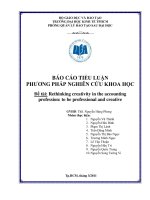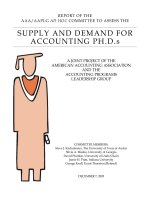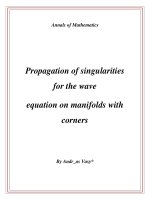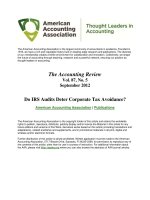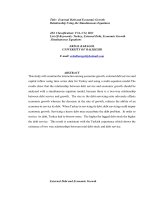The accounting equation
Bạn đang xem bản rút gọn của tài liệu. Xem và tải ngay bản đầy đủ của tài liệu tại đây (746.56 KB, 69 trang )
ACCOUNTING
1
CHAPTER 2
THE ACCOUNTING EQUATION
2
2
TOPIC LIST
1.
Assets, liabilities and the business entity
concept
2.
The accounting equation
3.
Credit transactions
4.
The statement of financial position
5.
Preparing the statement of financial position
6.
The statement of profit or loss
3
3
1
1
1. ASSETS, LIABILITIES AND THE BUSINESS
ENTITY CONCEPT
1.1. Assets and liabilities
Asset: a resource controlled by the entity as a
result of past events from which future economic
benefits are expected to flow to the entity.
4
4
1. ASSETS, LIABILITIES AND THE BUSINESS
ENTITY CONCEPT
1.1. Assets and liabilities
Asset: non-current assets v current assets
Land and buildings
Motor vehicles
Plant and machinery
Fixtures and fittings
Cash
Inventory
Receivables
5
5
1. ASSETS, LIABILITIES AND THE BUSINESS
ENTITY CONCEPT
1.1. Assets and liabilities
Liability: a present obligation arising from past
events, the settlement of which is expected to result
in an outflow from the entity of resources
embodying economic benefits.
6
6
2
2
1. ASSETS, LIABILITIES AND THE BUSINESS
ENTITY CONCEPT
1.1. Assets and liabilities
Examples:
Bank loan or overdraft
Payables
Taxation
7
7
1. ASSETS, LIABILITIES AND THE BUSINESS
ENTITY CONCEPT
1.2. The business as a separate entity
Business entity concept: a business is a separate
entity from its owner (strict legal position v
convention adopted by accountants)
8
8
1. ASSETS, LIABILITIES AND THE BUSINESS
ENTITY CONCEPT
1.2. The business as a separate entity
Capital: (equity in the context of company) residual
interest in the assets of the entity after deducting all
its liability.
9
9
3
3
2. THE ACCOUNTING EQUATION
2.1. What is the accounting equation
Accounting equation:
ASSETS = CAPITAL + LIABILITIES
In other words: the rule that the assets of a
business will at all time equal its liabilities plus
capital (balance sheet equation)
10
10
2. THE ACCOUNTING EQUATION
2.2. Assets = capital + liabilities
Worked examples p.40:
11
11
2. THE ACCOUNTING EQUATION
2.2. Assets = capital + liabilities
Historical cost: transactions are recorded at their
cost when they were incurred
12
12
4
4
2. THE ACCOUNTING EQUATION
2.3. Where do profits/losses fit into the accounting
equation?
Worked example p.41: Assets = capital + profit
Profit: the excess of income over expenses
Loss: the excess of expenses over income
13
13
2. THE ACCOUNTING EQUATION
2.3. Where do profits/losses fit into the accounting
equation?
Income: Increases in economic benefits over a period in
the form of inflows or increases of assets, or decreases
of liabilities, resulting in increases in equity/capital (CF).
It can include both revenue and gains
Expenses: Decreases in economic benefits over a
period in the form of outflows or depletion of assets, or
increases in liabilities, resulting in decreases in
equity/capital (CF).
14
14
2. THE ACCOUNTING EQUATION
2.4. Appropriation of profits: sole trader drawings
Drawings: Money and goods taken out of a
business by its owner
(Important: withdrawals or appropriations of profit
and not as expenses)
Worked example p.39 (S/M)
15
15
5
5
2. THE ACCOUNTING EQUATION
2.4. Appropriation of profits: sole trader drawings
Drawings: Money and goods taken out of a business
by its owner (Note: withdrawals or appropriations of
profit and not as expenses)
Worked example p.39 (S/M)
£
Net profit earned by the business
250
Less profit withdrawn by Liza
(180)
Net profit retained in the business
70
16
16
3. CREDIT TRANSACTIONS
3.1. Trade payables
Creditor: Person to whom a business owes money
(A trade creditor is a person to whom a business
owes money for trading debts)
Trade payables: The amounts due to credit
suppliers
17
17
3. CREDIT TRANSACTIONS
3.2. Trade receivables
Debtor: Person who owes money to the business
Trade receivables: The amounts owed by credit
customers
Worked example p.45
18
18
6
6
3. CREDIT TRANSACTIONS
3.3. Accruals concept
The accruals (or matching) concept requires that
income earned is matched with the expenses
incurred in earning it (*)
19
19
3. CREDIT TRANSACTIONS
3.3. Accruals concept
Interactive question 2:
How would each of these transactions affect the
accounting equation in terms of increase or
decrease in asset, capital or liability?
(a) Purchasing £800 worth of goods on credit
(b) Paying the telephone bill £25
(c) Selling £450 worth of goods for £650
(d) Paying £800 to a supplier
20
20
4. THE STATEMENT OF FINANCIAL POSITION
4.1. What is a statement of financial position?
The business's SFP shows its financial position at a
given moment in time.
03 key elements of SFP: liabilities, capital and assets
A SFP is very similar to the accounting equation - 02
differences:
The manner or format
The extra detail in SFP
Net assets: Assets less liabilities
21
21
7
7
4. THE STATEMENT OF FINANCIAL POSITION
4.1. What is a statement of financial position?
(In accordance to IAS 1, Presentation of F/Ss)
Name of business
Statement of financial position as at (date)
£
Assets (item by item)
X
Capital
X
Liabilities
X
X
22
22
4. THE STATEMENT OF FINANCIAL POSITION
4.2. Capital (Sole trader)
Capital is usually analysed into its component parts.
£
£
Beginning capital (ie, capital b/f or b/d)
X
Add additional capital introduced
X
X
Add profit earned (or less losses incurred)
X
Less drawings
(X)
Retained profit for the period
X
Capital as at the end (ie, capital c/f or c/d)
X
23
23
4. THE STATEMENT OF FINANCIAL POSITION
4.2. Capital (Sole trader)
'Brought forward' means that the amount is
brought forward from the previous period.
‘Carried forward' means carried forward to the
next period.
The carried forward amount at the end of one
period is therefore the brought forward amount
of the next period
24
24
8
8
4. THE STATEMENT OF FINANCIAL POSITION
4.2. Capital (Sole trader)
4.2.1. Equity (company)
The capital or equity side of a company's statement of
financial position is more complicated than a sole
trader's. We shall look at it in detail in Chapter 11
25
25
4. THE STATEMENT OF FINANCIAL POSITION
4.3. Liabilities
IAS 1 requires distinction between non-current liabilities
and current liabilities
Current liabilities are debts which are payable
within one year
Non-current liabilities are debts which are payable
after one year
26
26
4. THE STATEMENT OF FINANCIAL POSITION
4.3. Liabilities
Examples of non-current liabilities:
Loans which are not repayable for more than one
year, such as a bank loan or a loan from an
individual to a business.
Loan stock or debentures
27
27
9
9
4. THE STATEMENT OF FINANCIAL POSITION
4.3. Liabilities
Examples of current liabilities:
Loans repayable w/i one year, incl. the element of a
long term loan that is repayable w/i one year.
A bank overdraft
Trade payables
Other payables
Taxation payable to HMRC with respect to CT
Accruals.
28
28
4. THE STATEMENT OF FINANCIAL POSITION
4.4. Assets
IAS 1 requires distinction between non-current assets
and current assets
Non-current assets are acquired for long-term use
within the business. They are normally valued at cost
less accumulated depreciation.
Current assets are expected to be converted into
cash within one year
29
29
4. THE STATEMENT OF FINANCIAL POSITION
4.4. Assets
4.4.1. Non-current assets
Components of non-current assets
Property, plant and equipment (PPE) (ie, 'Tangible'
assets)
Intangible non-current assets (patent, goodwill)
Long-term investments
30
30
10
10
4. THE STATEMENT OF FINANCIAL POSITION
4.4. Assets
4.4.1. Non-current assets
Important: to be classed as a non-current asset, an item
must satisfy two conditions:
It must be used by the business. For example, the
owner's own house would not normally appear on
the business statement of financial position.
The asset must have a 'life' in use of more than
one reporting period or year
31
31
4. THE STATEMENT OF FINANCIAL POSITION
4.4.2. Non-current assets and depreciation
Non-current assets are held and used by a business for
a number of years, but they wear out or lose their
usefulness in the course of time. Every tangible noncurrent asset has a limited life. The only exception is
freehold land, although this too can be exhausted if it
is used by extractive industries (eg, mining).
32
32
4. THE STATEMENT OF FINANCIAL POSITION
4.4.2. Non-current assets and depreciation
The FSs of a business reflect that the cost of a non-current asset is
gradually consumed as the asset wears out. This is done by gradually
'writing off' the asset's cost in the statement of profit or loss over
several reporting periods. For example, in the case of a machine
costing £1,000 and expected to wear out after ten years, it is
appropriate to reduce the value in the statement of financial position by
£100 each year. This process is known as depreciation.
If a statement of financial position were drawn up four years after the asset
was purchased, the amount of depreciation accumulated over four
years would be 4 × £100 = £400. The machine would then appear in
the statement of financial position as follows.
33
33
11
11
4. THE STATEMENT OF FINANCIAL POSITION
4.4.2. Non-current assets and depreciation
£
Machine at original cost
1,000
Less accumulated depreciation
(400)
Carrying amount *
600
* ie, the value of the asset in the books of account, net of accumulated
depreciation. After ten years the asset would be fully depreciated and
would appear in the statement of financial position with a carrying
amount of zero.
The amount that is written off over time does not have to be the full cost of
the asset if it is expected to have a resale – or 'residual' – value at the
end of its useful life
34
34
4. THE STATEMENT OF FINANCIAL POSITION
4.4.2. Non-current assets and depreciation
Interactive question 3: Residual value
Suppose a business buys a car for £10,000. It expects to
keep the car for three years and then to sell it for
£3,400. How much depreciation should be
accounted for in each year of the car's useful life?
35
35
4. THE STATEMENT OF FINANCIAL POSITION
4.4.3 . Current assets
Current asset: An asset is current when it is expected to
be realised in, or intended for sale or consumption in,
the entity's normal operating cycle, or it is held for
being traded, or it is expected to be realised within
12 months of the date of the statement of financial
position, or it is cash or a cash equivalent.
36
36
12
12
4. THE STATEMENT OF FINANCIAL POSITION
4.4.3 . Current assets
Worked example p.48: Current assets
37
37
4. THE STATEMENT OF FINANCIAL POSITION
Interactive question 4: Asset classification
Identify which of the following assets falls into the noncurrent category and which should be treated as
current. Could any be treated as either?
Asset
Business
Van
Delivery firm
Current or non-current
Machine
Manufacturing company
Car
Car trader
Investment
Any
38
38
4. THE STATEMENT OF FINANCIAL POSITION
Interactive question 4: Asset classification
IMPORTANT!!!
The distinction between a non-current asset and a
current asset is not what the asset is physically, but
for what purpose it is obtained and used by the
business.
Further discussion: what a bout a building?
39
39
13
13
4. THE STATEMENT OF FINANCIAL POSITION
4.4.3 . Current assets
There are some other categories of current asset.
Short term investments.
Prepayments.
40
40
4. THE STATEMENT OF FINANCIAL POSITION
4.4.4.Trade and other receivables
A receivable can be due from anyone who owes the
business money
Two types of receivable.
Trade receivables represent customers who owe
money for goods or services bought on credit in
the course of the trading activities
Other receivables are due from anyone else owing
money to the business, (*)
41
41
5. PREPARING THE SFP
5.1. How is a basic statement of financial position
prepared?
Worked example: Statement of financial position (p.50)
42
42
14
14
5. PREPARING THE SFP
5.1. How is a basic statement of financial position
prepared?
Worked example: Statement of financial position (p.50)
Interactive question 5: Preparing a statement of
financial position p.51
43
43
6. THE STATEMENT OF PROFIT OR LOSS
6.1. What is the statement of profit or loss?
Gross profit = revenue from sales, less cost of sales
Profit for the period (ie. Net profit) = gross profit less
expenses plus non-trading income
44
44
6. THE STATEMENT OF PROFIT OR LOSS
6.1. What is the statement of profit or loss?
Gross profit is the difference between:
The value of sales revenue and
The purchase or production cost of the goods
sold: cost of sales
45
45
15
15
6. THE STATEMENT OF PROFIT OR LOSS
6.1. What is the statement of profit or loss?
(*) In many types of business the cost of sales also
includes:
The cost of employing those people directly
involved in making or providing a service
Maintenance and depreciation on non-current
assets used directly in making sales, plus losses
on their disposal
46
46
6. THE STATEMENT OF PROFIT OR LOSS
6.1. What is the statement of profit or loss?
6.1.1. Gross profit margin
Discussion: What is gross profit margin used for?
47
47
6. THE STATEMENT OF PROFIT OR LOSS
6.1. What is the statement of profit or loss?
6.1.2. Profit for the period
The net profit is:
Gross profit
X
Plus any other income from
sources other than the sale of goods
X
Minus other business expenses,
not included in the cost of goods sold
(Profit for the period/Net profit)
(X)
X
48
48
16
16
6. THE STATEMENT OF PROFIT OR LOSS
6.1. What is the statement of profit or loss?
6.1.2. Profit for the period
As far as possible, items of expense should be grouped
(distribution costs, administrative expenses, and finance
costs) but this is not something that you need worry about
at this stage
Worked example p.53
A SPL can be presented in various formats, but here we will
use a vertical format similar to the one used in IAS 1. (It is
not exactly the same.) (*)
49
49
6. THE STATEMENT OF PROFIT OR LOSS
6.2. Relationship between the SPL and the SFP
Net profit/A loss in SPL (for a sole trader) is
transferred to SFP as an addition to/deduction from
the owner's capital in SFP
Drawings are appropriations of profit and not
expenses. They must not be included in the SPL (*)
The cost of sales is £6,200, even though £700 of the
costs have not yet been paid for – Accruals concept
50
50
6. THE STATEMENT OF PROFIT OR LOSS
6.2. Relationship between the SPL and the SFP
Interactive question 6 p.58: Preparing a statement of
financial position 2
Prepare a statement of financial position as at 31 August
20X5 for Jock Heiss, using the information from the
Worked example above
51
51
17
17
End of Chapter 2
Thank you!
52
52
18
18
ACCOUNTING
1
CHAPTER 3
RECORDING FINANCIAL TRANSACTION
2
2
TOPIC LIST
1.
Computerised accounting systems
2.
Source documents for recording financial
transactions
3.
Recording bank transactions
4.
Petty cash book
5.
The payroll
3
3
19
1
1. COMPUTERISED ACCOUNTING SYSTEMS
1.1. Accounting system
Accounting system: a system to allow a bussiness
to record, process and store financial information
Manual accounting system
Computerised accounting system
4
4
1. COMPUTERISED ACCOUNTING SYSTEMS
1.1. Accounting system
Computerised accounting system
- Reports
- Trial balance
- Source
documents
- Financial
Statements
- Standing data
INPUTS
PROCESSES
OUTPUTS
- Ledgers
- Journals
- Calculations
- Record keeping
5
5
1. COMPUTERISED ACCOUNTING SYSTEMS
1.2. Accounting software package
Simple ‘offthe-shelf’
programmes
Fully
integrated
systems
Bespoke
accounting
systems
6
6
20
2
1. COMPUTERISED ACCOUNTING SYSTEMS
1.3. General points
Standing data – does not regularly change – tightly
controlled – many transactions rely on
Account codes – each of modules is sub-divided into
accounts and uniquely coded
Real-time processing: updates when transaction takes
place
Batch processing: processing usually end of day/week
Controls – to ensure continued reliability of the system
7
7
1. COMPUTERISED ACCOUNTING SYSTEMS
1.4. Cloud accounting
Cloud computing – software and data storage via
the internet
Cloud accounting – accountancy software provided
in the cloud by a service provider
8
8
2. SOURCE DOCUMENTS FOR RECORDING
FINANCIAL TRANSACTIONS
2.1. Source documents
Starting point to record transaction
9
9
21
3
2. SOURCE DOCUMENTS FOR RECORDING
FINANCIAL TRANSACTIONS
2.2. Recording information from source documents
Financial information contained in the source
documents is recorded in the computerised
accounting system
Eg. Credit sale => record:
Amount of the sale (exclusive of VAT)
Amount owned by customer (receivable)
VAT/discounts
Payments subsequently received
10
10
2. SOURCE DOCUMENTS FOR RECORDING
FINANCIAL TRANSACTIONS
2.3. Sales system
2.4. Purchases system
Customer order – sales order
Placing order – purchase
order
Dispatch goods – delivery
note
Receive goods – goods
received note (GRN)
Raise invoice – Sales invoice
Receive invoice – (Purchase)
invoice
Receive payment
Make payment
11
11
2. SOURCE DOCUMENTS FOR RECORDING
FINANCIAL TRANSACTIONS
2.5. Invoices
Invoices: source documents (sales INV, purchase
INV)
12
12
22
4
2. SOURCE DOCUMENTS FOR RECORDING
FINANCIAL TRANSACTIONS
2.6. Credit notes
Credit note: A document issued to a customer
relating to returned goods, or refunds when a
customer has been overcharged for whatever
reason. It can be regarded as a negative invoice.
Example and discussion (SM p.73)
13
13
2. SOURCE DOCUMENTS FOR RECORDING
FINANCIAL TRANSACTIONS
2.6. Credit notes
2.6.1. Debit notes
A debit note might be issued to a supplier as a means
of formally requesting a credit note from that
supplier
14
14
2. SOURCE DOCUMENTS FOR RECORDING
FINANCIAL TRANSACTIONS
Activity: Which ones are source documents?
Debit notes
Credit notes
Sales invoice
Purchase invoice
Sales order
Purchase order
Goods received notes
Cheques
Bank transfer slip
15
15
23
5
2. SOURCE DOCUMENTS FOR RECORDING
FINANCIAL TRANSACTIONS
2.7. VAT
VAT: sales tax added to most sales invoices in UK
Ultimately be paid to or received from HMRC
16
16
2. SOURCE DOCUMENTS FOR RECORDING
FINANCIAL TRANSACTIONS
2.8. Other source documents
Question: For sales and purchases on credit – can
you name some source documents???
17
17
2. SOURCE DOCUMENTS FOR RECORDING
FINANCIAL TRANSACTIONS
2.8. Other source documents
For sales and purchases on credit –
sales/purchases invoices; credit notes
Others:
Settlement of credit transactions (cheque, card
payment, bank transfer)
Cash
Wages
18
18
24
6
3. RECORDING BANK TRANSACTIONS
3.1. Electronic banking
Electronic banking has changed how business
record transactions through the bank
Traditionally: separate cash book – records all
bank cash transactions (At the end of month:
reconcile with bank statement)
Electronic banking: constant access to bank
accounts – use bank information to update
accounting records on regular basis
19
19
3. RECORDING BANK TRANSACTIONS
3.1. Electronic banking
Transaction report – source document =>
uploaded into computerised accounting system
‘Known’ transaction – matched and the system
processes
‘Unknown’ transaction (temp. account (suspense
account) – exception report)
Illustration page 75 (S/M)
20
20
3. RECORDING BANK TRANSACTIONS
3.2. Cash at bank account
Cash at bank account: record all receipts and
payments (uploaded from transaction report)
Physical cash and cheques: also be recorded in
cash at bank account (HOW?)
Petty cash: (notes and coins) – kept in business
premises to make occasional payments – separate
account
21
21
25
7
